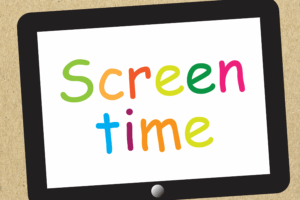In today’s modern world, kids are growing up with screens all around them.Whether it’s smartphones, tablets, computers, or televisions, screens have become an integral part of their lives.Determining the exact amount of screen time that is “too much” can be challenging, as it varies based on factors like age, individual needs, and the quality of content consumed. However, several key guidelines and studies can help us establish some boundaries.
In this blog post, we’ll explore the impact of excessive screen time on children’s development and provide recommendations for healthy time limits for them.
The Screen Time Dilemma
Children’s time spent on electronic devices has been a topic of debate among parents, educators, and healthcare professionals. While screens can be powerful educational tools, excessive use can have adverse effects on their physical and psychological development.

To begin our exploration, it’s essential to establish what we mean by “screen time.” Screen time encompasses any time a child spends in front of a digital screen, whether it’s watching videos, playing video games, or using educational apps. It’s important to differentiate between quality screen time, which offers educational value, and excessive, mindless screen time that may lead to adverse consequences.
Recommendations by Age
Screen time recommendations by age are general guidelines provided to help parents and caregivers determine appropriate limits for their children’s use of electronic devices, such as smartphones, tablets, computers, and televisions.
These guidelines take into account the developmental needs and potential risks associated with excessive time spent on electronics at different stages of a child’s growth. Here are some common recommendations by age groups:
Infants (0-18 months):
- The American Academy of Pediatrics (AAP) recommends avoiding screen time for infants except for video chatting with family.
- It’s essential for infants to interact with caregivers and the physical world for healthy development.
Toddlers (18-24 months):
- Very limited screen time to high-quality, educational programming or apps.
- Co-viewing with parents or caregivers is beneficial to enhance understanding.
Preschoolers (2-5 years):
- The American Academy of Pediatrics (AAP) recommends that children in this age group should have no more than one hour of high-quality time spent on electronics per day.
- Encourage interactive and educational programs that promote learning.
School-age children (6-18 years):
- Encourage a balanced approach, combining time spent on electronic devices with physical activity, homework, and face-to-face interactions.
- Set consistent time limits that allow for healthy sleep routines.
Teens (13-18 years):
- Promote responsible use of screens and social media.
- Encourage open communication about online experiences and safety.
It’s important to remember that these recommendations are general guidelines, and individual circumstances may vary. Parents and caregivers should consider their child’s unique needs and adapt the screen rules accordingly. Additionally, the quality of screen time matters as much as the quantity. Prioritizing educational and age-appropriate content is crucial, and co-viewing or co-playing can enhance the learning experience.
Balancing time spent on electronics with physical activity, family interactions, and other real-world experiences is key to supporting a child’s healthy development. Regularly revisiting and adjusting the rules as children grow and their needs change is essential to ensure a healthy and productive relationship with technology.
The Impact of Excessive Screen Time
Excessive screen time for children can result in several detrimental outcomes:
Sedentary Lifestyle
Prolonged hours in front of screens often lead to a sedentary lifestyle, which can contribute to health issues like obesity and poor physical fitness.
Sleep Disruption
The blue light emitted by screens can disrupt children’s sleep patterns, leading to insomnia and other sleep-related problems.
Cognitive Development
While some time spent on electronic devices can be educational, too much of it can hinder cognitive development and the ability to engage in creative, independent play.Now, let’s delve into the consequences of excessive time spent in front of screens and how it affects different aspects of a child’s development.

- Negative Effects on Brain Development
Excessive screen time has been associated with a range of negative effects on the developing brain. It can lead to decreased attention spans and impair cognitive skills. Research suggests that heavy screen use may affect children’s ability to think critically and make sound decisions.
- Language and Communication Development
Prolonged exposure to screens, especially when used passively (such as watching TV), can hinder language and communication skills. This can lead to speech delays, impacting a child’s ability to express themselves effectively.
- Social Skills and Interaction
Screen time can also affect a child’s social skills. Excessive use of digital devices may lead to isolation and reduce opportunities for face-to-face interactions. Children need these experiences to develop crucial social skills like empathy, cooperation, and conflict resolution.
Behavioral Issues
Studies suggest that excessive time spent in front of screen is linked to an increased risk of attention problems and behavioral issues in children.
It’s important for parents and caregivers to be vigilant and watch for symptoms,which can include:
- Irritability

- Difficulty concentrating
- Reduced interest in other activities
- Poor academic performance
- Sleep disturbances
Benefits of Screen Time
While we’ve discussed the negative effects of excessive screen time, it’s essential to acknowledge that not all time spent on digital devices is harmful. When used in moderation and for educational purposes, screens can offer several benefits for child development:
- Educational Content
Well-chosen educational apps, websites, and games can enhance a child’s learning experience. They can reinforce academic concepts and foster creativity and problem-solving skills.
- Skill Development
Time spent on electronic devices can help children acquire digital literacy skills that are increasingly important in the modern world. These skills include typing, online research, and using software tools.
- Entertainment and Relaxation
Just as adults need downtime, children also benefit from a healthy balance between activities. Screen time can provide entertainment and relaxation when used mindfully.
Setting Healthy Screen Time Limits
Establishing limits is essential for promoting a balanced lifestyle. Here are some suggestions for establishing good limits:
1.Set Clear Limits
Establish clear and consistent rules regarding using electronics . Define when and how much screen time is allowed on a daily or weekly basis.
2.Encourage Outdoor Activities
Make time for physical activities and outdoor play, ensuring that your child gets the recommended amount of exercise.
3.Choose Quality Content
Make sure that the stuff your child watches or reads is both educational and suitable for their age.There are plenty of educational apps and programs available that can stimulate learning.
4.Create Tech-Free Zones
Designate certain areas of your home, such as the dining room or bedrooms, as screen-free zones to encourage family interaction and quality time.
5.Engage with Your Child
Co-view or co-play with your child when they are using screens. This allows you to monitor the content they are exposed to and discuss it with them.
6.Use Parental Controls
Many devices and apps come with built-in parental control features. Utilize these tools to set time limits and filter content.
7.Be a Role Model
Children often learn by example. Be a positive role model for your children. Demonstrate responsible screen usage by limiting your own time spent on electronic devices.
In a world dominated by screens, it’s crucial for parents and caregivers to strike a balance between the benefits and risks of screen time for children. While some screen time can be beneficial, excessive use can lead to a range of negative effects on a child’s development. By following age-appropriate screen time recommendations,you can ensure that their time spent on electronics is both educational and enjoyable without compromising their overall well-being. Remember, the key is moderation and mindful use of technology to promote healthy growth and development.
In conclusion, the question of how much screen time is too much for kids doesn’t have a one-size-fits-all answer. It’s about striking a balance that aligns with your child’s age, developmental needs, and your family’s values. The key is to be aware of the potential risks, set boundaries, and encourage a healthy lifestyle that includes a mix of screen time and other activities. By doing so, you can help your child navigate the digital world while fostering their physical and mental well-being.
Remember, as parents and caregivers, our role is not to eliminate electronics from our children’s lives but to guide them towards responsible and balanced usage. In this way, we can empower them to make informed choices in the digital age
